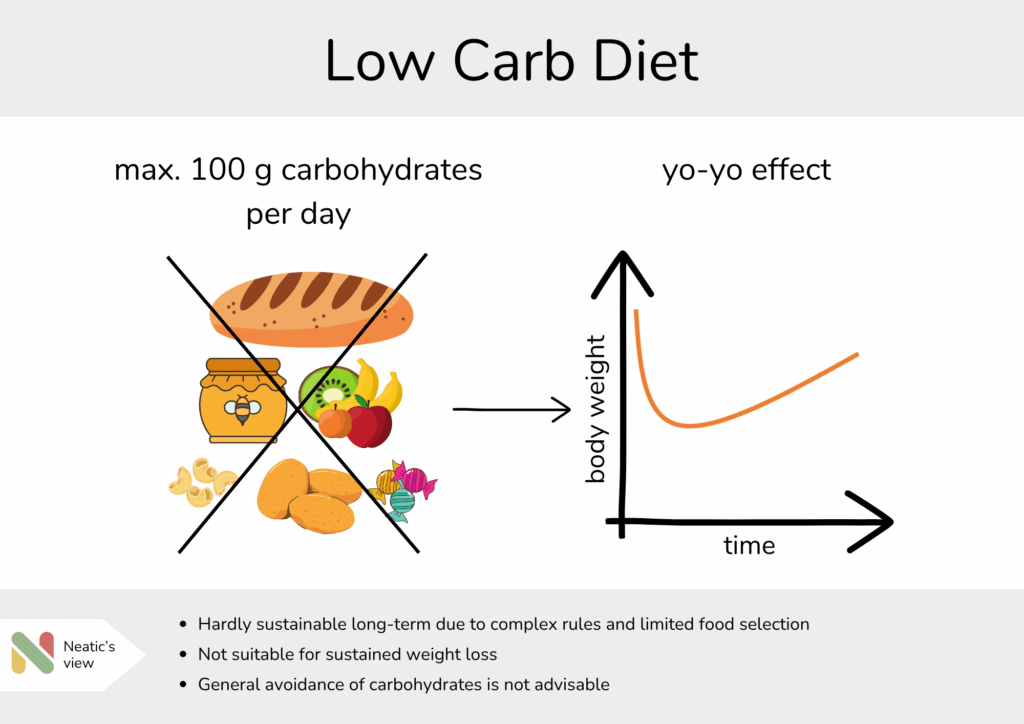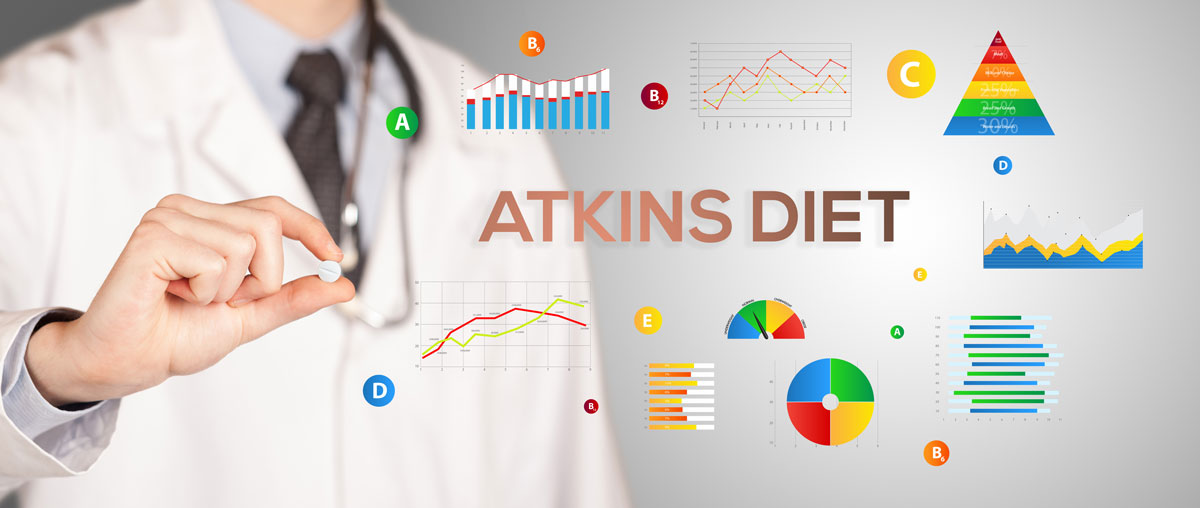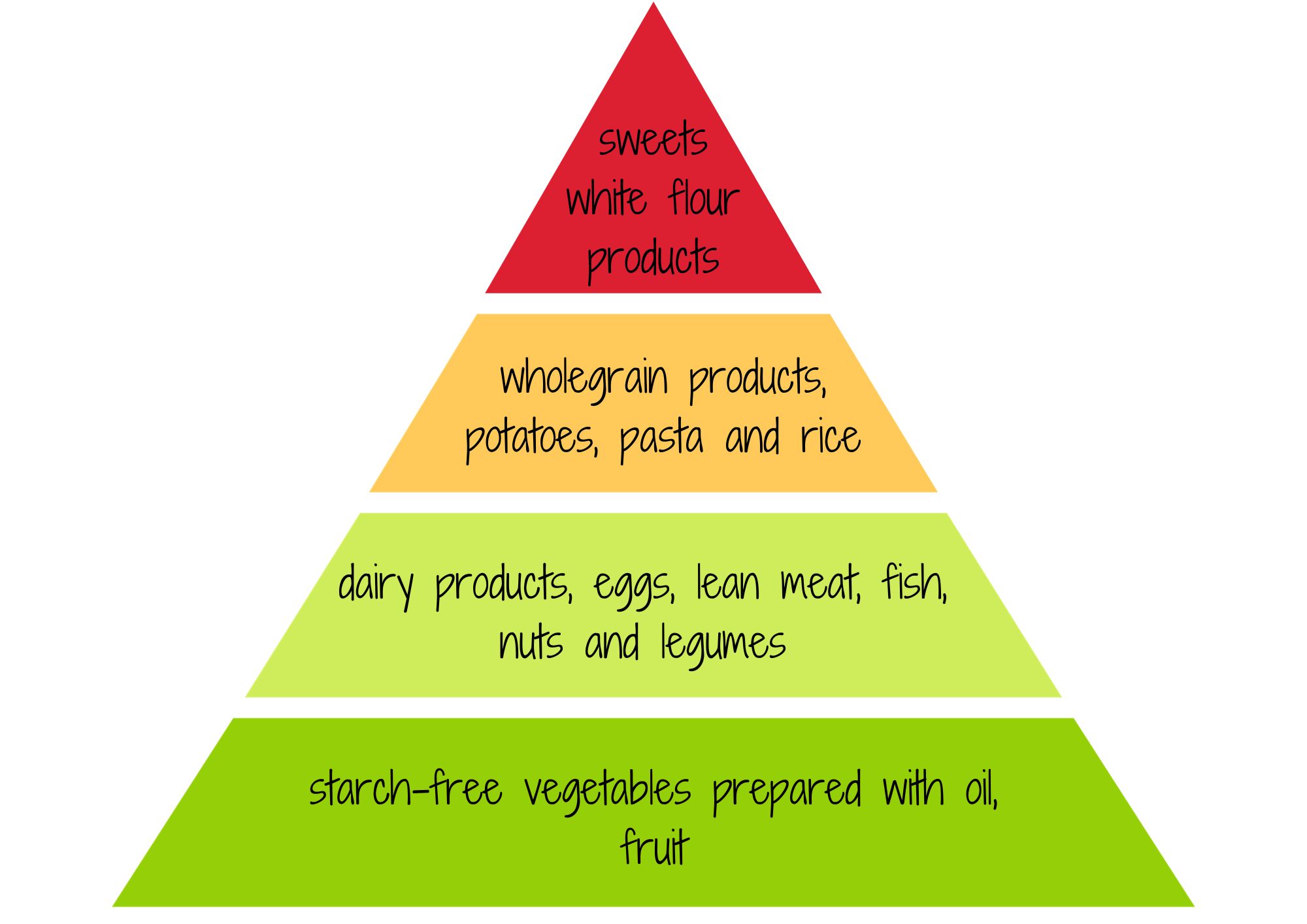
Major points:
- Low carb diets focus on reducing the overall carbohydrate intake to a maximum of 100 g per day.
- Low carb diets can lead to short-term weight loss, but are difficult to maintain long-term.
- Neatic advises against a general carbohydrate reduction without considering their sources since this does more harm than good.
What are low carb diets?
The maximum amount of carbohydrates in grams that can be consumed varies depending on the low carb diet. Often, the recommendation is to consume no more than 100 g of carbohydrates per day, without distinguishing between their type.
The German Society for Nutrition (DGE) recommends that a healthy individual should consume over 50% of their daily energy intake in the form of carbohydrates. For an energy requirement of 2000 calories, this equals at least 250 g of carbohydrates per day. However, if only 100 g of carbohydrates are consumed per day, this only accounts for 20% of total energy intake.
When fewer carbohydrates are consumed, the pancreas produces less insulin, a hormone that is important for stabilizing blood sugar levels. A lower insulin level also promotes fat burning. Additionally, the body switches from its normal metabolism to an “artificial” starvation metabolism. This produces ketone bodies as an alternative source of energy. Therefore, an initial weight loss is often achieved with low carb diets.

What does science say?
Low carb diets promise losing weight easily and quickly. Studies show that they can help to lose weight short-term, but this cannot be sustained over the long-term.
One particularly well-done study on low carb diets was published in 2008 (Shai et al., 2008). In the so-called Dietary Intervention Randomized Controlled Trial (DIRECT), three groups with around 100 participants each were created: low carb diet, low fat diet, and Mediterranean diet. At the workplace, meals were prepared and labeled according to group classification. This ensured that meals during working hours were definitely of the respective diet form. In addition, family members were trained on low carb diets.
Within the first six months, the highest weight loss occurred in the low carb group, with over 6 kg weight loss (Shai et al., 2008). After six months, the weight slowly increased again. After two years, total weight loss was 4 kg on average, and after six years it was just under 2 kg (Shai et al., 2008, Schwarzfuchs et al., 2012).
Similar results were obtained in another two-year study (Foster et al., 2010). Again, weight loss was most pronounced in the first six months. After that, participants slowly regained weight (Foster et al., 2010).
As with all dietary studies, a major problem is that many study participants did not follow through to the end. For example, 24 of 109 (Shai et al., 2008) and 64 of 153 (Foster et al., 2010) participants dropped out of the aforementioned studies within two years. It cannot be ruled out that these participants were disappointed with their weight loss progress.
Examples of low carb diets
There are many different low carb diets. Most are structured in stages or phases. In the beginning, the goal is to achieve rapid weight loss by severely restricting carbohydrate intake. After that, carbohydrate consumption is slowly increased again but remains nevertheless restricted.
In the following section the most popular low carb diets are summarized:

Atkins diet: The Atkins diet is a classic low carb diet divided into four phases.
- Phase 1: A maximum of 20 g of carbohydrates per day is eaten for 14 days. Salad, eggs, and meat are on the menu.
- Phase 2: Carbohydrate consumption is increased by 5 g each week until a daily amount of 40 to 60 g is reached. This phase lasts about four to eight weeks. Nuts, berries, and some legumes may be eaten again.
- Phase 3: As long as the weight continues to drop, the daily amount of carbohydrates may be increased by 10 g per week. This is done to find out how many carbohydrates can be eaten without weight regain. This phase can last for different lengths of time.
- Phase 4: This phase is about weight maintenance and carbohydrate consumption is typically between 80 and 100 g per day. Foods such as pasta, potatoes, and rice can be eaten from time to time.
Low-glycemic index (GI) diet: Here, a distinction is made between “good” and “bad” carbohydrates. Bad carbohydrates have a high GI. This indicates how much the blood sugar rises after consumption of a carbohydrate-containing food. The higher the GI, the greater the rise in blood sugar. A traffic light system may help to assess the food. Here, foods with a low GI (e.g., peanuts, lentils, whole-grain pasta) are classified in the green range, foods with a medium GI (e.g., granola bars with dried fruit, jacket potatoes, fine whole-grain bread) in the yellow range, and foods with a high GI (e.g., glucose, white bread, mashed potatoes) in the red range.
South Beach Diet: This diet is a variation of the low-GI diet. It consists of three phases.
- Phase 1: Carbohydrates (including fruit) are completely eliminated for two weeks.
- Phase 2: Fruit, vegetables, whole-grain bread, and legumes are slowly reintroduced.
- Phase 3: In the long-term phase, mainly foods with low GI should be eaten.
Logi Method: In this diet, the focus is also on the GI. There is no strict diet plan. However, carbohydrates should only be consumed in moderation. Vegetables, salads, fresh fruit, and protein-rich foods such as meat, fish, dairy products, nuts, and pulses are recommended. When choosing fats, high-quality fats and oils should be selected. The goal is to keep the rise in blood sugar after meals as low as possible. The Logi pyramid represents in four levels from bottom to top in which frequency foods should be eaten: often, frequently, little, and rarely.

What does Neatic recommend concerning low carb diets?
Neatic, as opposed to low carb diets, does not restrict all carbohydrates across the board but specifically avoids mono- and disaccharides added to foods during the manufacturing process. These include table sugar, glucose, and fructose. Furthermore, sugars that are naturally present in honey, syrups, fruit juices, and fruit juice concentrate are restricted.
The consumption of fruits and polysaccharides is allowed without any restrictions. Polysaccharides are found in grain, legumes, and potatoes, as well as in foods made from them.
Do you want to know why Neatic does not restrict polysaccharides and fruit? The answer is simple. Because there is no scientific data that these carbohydrates cause obesity! On the contrary, fruit consumption even has a positive effect on body weight. In addition, it becomes much more difficult to follow through with the dietary changes if all carbohydrates are limited.
Neatic does not recommend a general reduction in carbohydrates!
If you are still unsure about the principle ‘limit sugar’, you can read everything you need to know here.

Bibliography:
Foster, Gary D.; Wyatt, Holly R.; Hill, James O.; Makris, Angela P.; Rosenbaum, Diane L.; Brill, Carrie; Stein, Richard I.; Mohammed, B. Selma; Miller, Bernard; Rader, Daniel J.; Zemel, Babette; Wadden, Thomas A.; Tenhave, Thomas; Newcomb, Craig W.; Klein, Samuel (2010): Weight and Metabolic Outcomes After 2 Years on a Low-Carbohydrate Versus Low-Fat Diet: A Randomized Trial. Ann Inter Med 153 (3), pp. 147–157. DOI: 10.7326/0003-4819-153-3-201008030-00005.
Grillparzer, Marion (2013): Die neue GLYX-Diät. Abnehmen mit dem Gücks-Gefühl. 6. Aufl. München: Gräfe und Unzer.
Gunda Backes (2018): Entgiftungsdiäten, Schlank im Schlaf-Diät, HCG-Diät – ein Überblick. DGEinfo (3), pp. 39–45.
Gunda Backes (2018): Paleo-Diät, Glyx-Diät, Formula-Diäten – ein Überblick. DGEinfo (4), pp. 56–62.
Höfler, Elisabeth; Sprengart, Petra (2018): Praktische Diätetik. Grundlagen, Ziele und Umsetzung der Ernährungstherapie. 2., überarbeitete und erweiterte Auflage. Stuttgart: WVG, Wissenschaftliche Verlagsgesellschaft.
Schwarzfuchs, Dan; Golan, Rachel; Shai, Iris (2012): Four-year follow-up after two-year dietary interventions. N Engl J Med 367 (14), pp. 1373–1374. DOI: 10.1056/NEJMc1204792.
Shai, Iris; Schwarzfuchs, Dan; Henkin, Yaakov; Shahar, Danit R.; Witkow, Shula; Greenberg, Ilana; Golan, Rachel; Fraser, Drora; Bolotin, Arkady; Vardi, Hilel; Tangi-Rozental, Osnat; Zuk-Ramot, Rachel; Sarusi, Benjamin; Brickner, Dov; Schwartz, Ziva; Sheiner, Einat; Marko, Rachel; Katorza, Esther; Thiery, Joachim; Fiedler, Georg Martin; Blüher, Matthias; Stumvoll, Michael; Stampfer, Meir J. (2008): Weight loss with a low-carbohydrate, Mediterranean, or low-fat diet. N Engl J Med 359 (3), pp. 229–241. DOI: 10.1056/NEJMoa0708681.
Worm, Nicolai (2011): Glücklich und schlank. Mit viel Eiweiß und dem richtigen Fett ; das komplette LOGI-Basiswissen ; mit umfangreichem Rezeptteil. 11. Aufl. Lünen: Systemed-Verl.
